Top-rung Ford F-150 adds hybrid power
By John Gilbert
What would you get if you crossed the concepts of the largest-selling vehicle in the world — the Ford F-150 half-ton pickup truck — with, say, a Prius? If you guess a tiny pickup, you’d be wrong; if you guess a gigantic super-powered hybrid pickup, you get a gold star.
The competition among top pickup manufacturers has never been more ferocious, even though the F-150 continues to hold serve for four decades as the top-selling vehicle in the country, and the world. The new Chevrolet Silverado is making a move up to regain the runner-up spot it yielded to the Ram 1500 a year ago, but the Ram was just awarded Motor Trend’s Truck of the Year for 2021, an unprecedented third straight year for Ram to win that honor.,
If you keep track of such things, you might have found it curious that Motor Trend ran the Ford Super-Duty heavyweight F-250 and F-350 against the winning Ram, but for competition it only offered the 2020 F-150. That’s because Ford was preparing to unveil the new 2021 F-150, and it was cloaked in some secrecy along the way. It came out just in time to win the North American Truck of the Year competition.
The opportunity to spend time with an F-150 PowerBoost for a week provided convincing evidence that the big Ford is also staking claim to the title of highest of high-tech pickups. My first suspicion was when I saw the plaque on the side that said “PowerBoost,” which is different from EcoBoost, Ford’s name for its turbocharging process on various engines. I had heard that Ford was thinking about adding a hybrid version to its vast array of F-150 models, so I followed up, and, sure enough, the PowerBoost is the new hybrid.
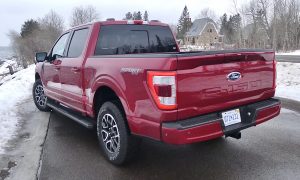
The Hybrid F-150 doesn’t look different, but its hybrid gas-electric system is the next step forward for pickups.
It is powered by a 3.5-liter V6 that is designed with a 44-horsepower permanent-magnet synchronous electric motor sandwiched between the V6 and the 10-speed automatic transmission. That is not unlike the design Honda used when it first brought out the hybrid Insight to take on the Prius. In the F-150’s case, there is also additional 1.5-kilowatt-hour lithium-ion battery under the pickup bed. When all systems are going, the PowerBoost turns out 430 horsepower and 570 foot-pounds of torque.
Those figures are increases of 30 horses and 70 foot-pounds compared to the 3.5 EcoBoost. And they are enough to give the truck a 2,120-pound payload, and a 12,700-pound towing capacity.
Competition is so intense among pickup builders that the Ram has won accolades for its flashy and refined interior, with a huge, iPad-sized navigation screen in the middle of the center stack. Ford obviously is up to the challenge, and it has done some impressive things to its interior for 2021. The truck, incidentally, has a new look because it has all-new body panels, affixed to the previous and substantial platform. The seats are improved, the graphics are vastly improved, and Ford pulled out all the stops to turn the huge interior into a mobile office.
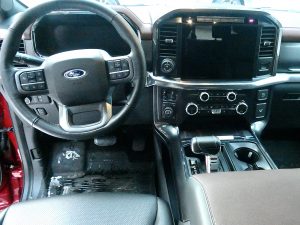
Interior advances include a console that will hold hanging files, and flip to become a computer desk.
Open the center console and you find a cave-like expanse that will hold hanging files, or a small dog with spacious room. The trick, however, is to turn the padded top of the console into a desk, which is easily done if only you could get the transmission’s shift lever out of the way. When you look at the shift lever, it has its indicator letters along the left edge of the console, and at the leading edge, there is a silver button. Push that button, and the sturdy shift lever folds itself forward and down flat, into a receptacle built just for that duty. Then you flip the console top forward, flat, and there is your desk. There also are a couple of electrical outlets if you want to hook up a coffee-maker, or a copying machine.
The huge navigation screen is accompanied by an 8-inch screen between the two primary gauges on the instrument panel. That gives you a nifty little revolving pictograph of the truck, which rotates to display what driving mode you’ve engaged, such as 2-wheel-drive, and assorted 4WD settings that run from 4A (Automatic), Normal, Eco, Sport, Sport Plus, and for various off-roading or specialized conditions, such as Slippery, or Mud, or Deep Snow or Deep-Sand.
There was no information with the new truck, because it was a “pre-production” model, not intended for sale, but to show off Ford’s truck-building prowess. The Rapid Red paint job made the F-150 pop out of the snowy mists, whenever that wintry blend hit the North Shore area near our Duluth home. My wife, Joan, privately dislikes big trucks for both their lack of easy visibility andan their bulk for climbing aboard and for driving ease. With only moderate arm-twisting, she agreed to drive the F-150 downtown and back, and while she didn’t say anything afterward, she admitted it was easier than most to enter and exit, to look over the rounded corners, as well as in overall handling.
For an adventure last Sunday, we decided to make our first trip to the unique “Sax-Zim Bog” near Meadowlands, a tiny village off to the west of Hwy. 53, which is the main artery from Duluth to the Iron Range cities. The attraction of the Sax-Zim Bog is best explained if you ever saw the low-key Steve Martin movie about a nutty guy who became transfixed by bird-watching, or “birding,” in which people travel the world over to try to see how many species of birds they can log in a single year. The movie was called “The Big Year,” and while I love to look for raptors everywhere, I wouldn’t have bothered watching the movie if it hadn’t been on an airplane’s video system during a flight from the West Coast to Minneapolis. It was interesting, particularly because the climactic scenes of these “bird-nerds” was when they went to this primitive wooded area in north-central Minnesota. The Sax-Zim Bog.
Armed with our big F-150, we felt pretty well prepared for our quest, to find a Great Gray Owl or a Northern Hawk Owl. We settled for only the navigation map without installing a destination on the big screen, and it did the job to show us the assorted little townships around Meadowlands. We turned left onto Hwy. 133 and headed west, and on a hunch we turned right to go north on Hwy. 7. That area is about a 20-by-20 mile area of bog, which I knew about because long before I was born, my mother’s family owned a large farm out between McGregor and Meadowlands. It was rich, peat-bog soil, and my mom used to tell me about taking a train ride from Duluth to that area to visit the farm of Dr. John McKay, the area’s primary veterinarian. The family sold the farm to Jeno Paulucci, the Duluth entrepreneur who used it to grow the many vegetables for his canned Chinese food varieties.
We knew our trip would be unlikely to match the phenomenon of the influx of owls from Canada a decade ago, when they flew down to feast on the little critters they could find, and we would see many of them near Stoney Point, fairly near our home. Sunday is a good day to listen to Sirius Satellite radio, but before we turned off on Hwy. 133, our Satellite signal went quiet and wouldn’t come back no matter how we tried. We talked about how the area was so devoid of population, satellite radio would be a major attraction. As we headed north on Hwy. 7, we passed a side-road named “McKay Road.” Hmm, I wondered. Could there be a connection, after most of a century?
We circled around, turning west on Arkola Road, and then left again on Owl Avenue, to get to the obscure but helpful nature center, with maps offered to dozens of area feeders, and tips on where we might find various birds from a very knowledgeable and friendly fellow. As we listened, several grosbeaks cavorted in a tall feeder. A steady stream of visitors like us and various folks from the Twin Cities and the immediate area appreciated the information, and we walked a half-mile up a well-maintained boardwalk toward various other trails. We say a woodpecker. A couple of other hikers said they saw nothing,. We went back to the F-150 and ventured out to try a few other areas.
We parked at the Warren Nelson Memorial Bog, adjacent to the Warren Woessner Bog Boardwalk, which had boardwalks to feeders for a good view of a few squirrels and a few chickadees. As we headed back, a fellow with a gigantic camera lens asked if we had seen anything. Squirrels and chickadees, I told him. “Were they Boreal Chickadees?” he asked. I told him I didn’t know the difference, and he said, “Boreal Chickadees have brown plumage on the sides, instead of black.” I told him no, we only saw the non-Boreal type.
Joan told me when I had parked on the very narrow shoulder of the road, several visitors watched, and when I tried to adjust my spot, it felt as though the F-150 was going to slide down into a deep ditch, so I gave it a small dose of power and it pulled right out. “Those people were impressed that you went off the road and saved it,” Joan said. Score one for the F-150 PowerBoost. It felt unsteady, which is what you get with a steep slope, and soft snow on top of long prairie grass. If I had slipped over the edge, we’d probably still be there, trying to get a visa to stay in Meadowlands.
The fellow advised us if we checked various places, such as down the Stone Lake Road, we might spot an owl or two, because while they prefer dawn or dusk, it was a dark enough day that they might be checking their hunting spots. Be aware, though, that hawks sit in treetops, but owls sit halfway up the trees.
Down the Stone Lake Road we went, only slightly confused by East Stone Lake Road, West Stone Lake Road and Stone Lake Road. Some neat lake cabins hidden back in there, but as we headed back toward County Road 7, I was just about to remark to Joan how lucky I usually am to spot big hawks sitting in trees well off roads like that, when suddenly she said: “Big bird, off to the right n a big tree, and not at the top.”
I stopped and threw it into reverse, backing up gently on the deserted road, about 100 feet to where I got a glimpse of the bird. With keyless operation, I had the F-150 keys in my parka pocket, and as I jumped out, thinking how lucky I was to have a large truck to hide me as I focused my 600 mm.. Leica lens on my Lumix camera. I hit the ground and took three steps, which was all I got before the silence was shattered by the F-150’s convenience alerting horn — four or five loud, staccato honks. I jumped about a foot, and when I looked, I saw a flash of wings as whatever large bird was in that tree dove and flew away.
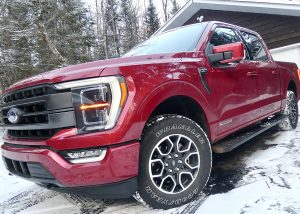
New F-150 collects all the recent advances and tops them with the battery-bolstered hybrid supplement.
Virtually all of the newest creature features are on the new F-150, and virtually all of them are much appreciated. Features such as lane-change warning, back-up view, brake assist, a fold-down desk between the front buckets, an onboard generator, a 10-speaker audio upgrade. Then there’s that warning series of honks for anyone who leaves the vehicle running and gets out with the key in his pocket to shoot a hasty photo. That is another wonderful feature if you live in any city or suburb in the country. But if you live in Meadowlands, Minnesota, that might be a high-tech feature of the 2021 Ford F-150 PowerBoost that is too high-tech for its owner’s own good.


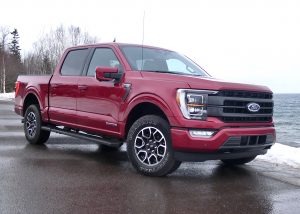
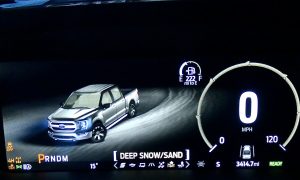
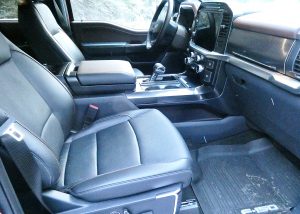
 John Gilbert is a lifetime Minnesotan and career journalist, specializing in cars and sports during and since spending 30 years at the Minneapolis Tribune, now the Star Tribune. More recently, he has continued translating the high-tech world of autos and sharing his passionate insights as a freelance writer/photographer/broadcaster. A member of the prestigious North American Car and Truck of the Year jury since 1993. John can be heard Monday-Friday from 9-11am on 610 KDAL(www.kdal610.com) on the "John Gilbert Show," and writes a column in the Duluth Reader.
John Gilbert is a lifetime Minnesotan and career journalist, specializing in cars and sports during and since spending 30 years at the Minneapolis Tribune, now the Star Tribune. More recently, he has continued translating the high-tech world of autos and sharing his passionate insights as a freelance writer/photographer/broadcaster. A member of the prestigious North American Car and Truck of the Year jury since 1993. John can be heard Monday-Friday from 9-11am on 610 KDAL(www.kdal610.com) on the "John Gilbert Show," and writes a column in the Duluth Reader.